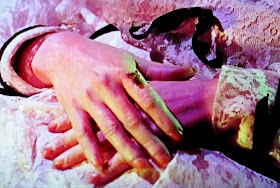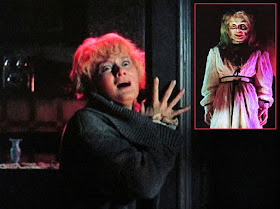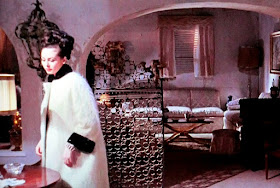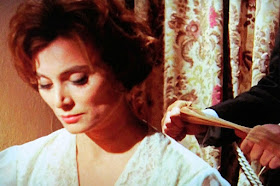What I didn't know when I watched it initially is that this was a different cut from the original version of the movie. The Italian-French film, directed by the esteemed Mario Bava, was determined to contain elements unsuitable for an American audience of that time and so it was edited here and there and rearranged a bit for release through American International Pictures (AIP.) I have no doubt that the first version of the movie was the best (and likely doesn't suffer from dubbing as bad as some of this is), but even the revised one was positively dripping with atmosphere and was effective in its own right.
A trio of creepy tales is presented by legendary horror star Boris Karloff, who played the iconic living corpse in Franken- stein (1931) and some of its sequels and later provided the narration along with the voice of The Grinch Who Stole Christmas (1966.) Karloff had hosted his own TV series Thriller (1960-1962) and was a familiar persona in this capacity. His introductions to the tales at hand are sometimes different in the two renditions of the movie. In this one, they have a slight tongue-in-cheek aspect, not unlike the sort of thing Alfred Hitchcock had done on his long-running show.
"The Drop of Water," a period piece set in turn of the century London, concerns a lonely nurse (Jacqueline Pierreux), one who isn't particularly well-to-do, receiving a call late at night to come to a large, rather run-down mansion. Is it me or does this telephone look rather like a face with bulging eyes? You might think more of it later in the story!
Annoyed at having to leave her humble apartment after having gotten comfortable and poured herself a drink, she nonetheless dresses and heads out the door.
Upon arrival at the dimly-lit, cat-filled, litter-strewn house, she is greeted by a nervous house- keeper, the woman who made the call to the nurse. The jumpy, superstitious housekeeper can hardly wait to get the job at hand done and get out of the house.
The job, by the way, is to clean and dress the corpse of the home's owner, an elderly medium who has passed away in her bed just after performing a seance. Pierreux had been her caregiver beforehand due to a heart condition, administering camphor to her.
The medium's dead face is paralyzingly scary, with it's gaunt, drawn features and wide-open eyes. This is simul- taneously hilarious also, thanks to the garish expression, but undeniably creepy.
Pierreux begins to work on the body, closing its eyes and undressing it while the house- keeper scurries about looking for the proper clothing and shoes to place upon it. While the eyes are shut, nothing can get that crooked toothy "grin" on the woman's face.
The nurse can't help but notice a considerable ring on one of the corpse's fingers and, after not much deliberation, she decides she is entitled to a bit of a bonus for the unpleasant work she's being called upon to do in the middle of the night. While attempting to prevent the housekeeper from finding out about it, she removes the stubborn ring from the dead hand and it goes careening to the floor!
During her frantic search, a glass of water is knocked over and drips. She does recover the ring. However, a stubborn fly keeps buzzing around and landing on the finger where the ring used to be!
Finally free of the body, the mansion and the jittery house- keeper, Pierreux heads back home to relax and admire her new piece of jewelry. But then it begins... She starts to hear water dripping.
Time and again, she is startled by the overem- phasized sound of water dripping from here and there. Each time she "fixes" the problem, it starts up somewhere else! Our friend the fly is back, too. The tension in this sequence is palpable, especially if one is watching alone in silence.
Finally, she opens the door to her bedroom and is horrified to find the dead woman's body, upright in her own bed! Again, while the image of this dead lady is in some ways amusing, there remains a chilling aspect as it glides towards her with malfeasance in mind.
The tale ends with a bit of a twist, though most of you will be able to see it coming. (And do you also see any resem- blance between the face of the telephone and that of the twisted, threatening corpse?)
The next story, "The Telephone," takes place in contem- porary times. Luscious Michele Mercier comes into her well- appointed basement apartment sporting a chic evening gown, furry coat and hair piled up to there. She's barely made it inside when the phone rings.
Her life is threatened by a male voice and she hangs up in disgust. As she undresses and lets her hair down, the phone rings again and it's the same menacing man as before.
It's a man who went to prison based on testimony of hers. Not only is he exclaiming that he will kill her, but he seems to be able to see everything she is doing! This includes her changing into a diaphanous dressing gown and hiding her money under a sofa cushion.
Now uneasy in the extreme, she closes every conceivable window, curtain and blind, even taking care to press the end of a handkerchief into the keyhole to her front door.
Still, the calls continue. Desperate, she calls a woman (Lydia Alphonsi) who isn't exactly a friend, but who is aware of the man and who may be able to help her fend him off. Alphonsi, who unquestionably has a mysterious air about her, comes to Mercier's apartment in order to keep her company.
The two strike up an unsure alliance, with Alphonsi promising to stay awake in Mercier's apartment while she tries to get some sleep. She fixes Mercier some hot tea with a sedative in it and changes into one of Mercier's nightgowns.
Alphonsi begins composing a letter at a desk, but before she can finish it, an intruder has slipped into the apartment and is coming up behind her!
(This tale underwent the most re-tooling of all for the AIP version. Initially, it was very clear that Mercier was a call girl and that Alphonsi had enjoyed a past lesbian relationship with her. The redone version does include a fair amount of suspense, but the storyline and the logic behind it is clouded somewhat.)
In any event, Mercier is absolutely stunning to look at throughout and, even though it doesn't last very long, her initial look with the black gown, diamond brooch and vertical hair just makes our day!
The third, and longest, story in this triad is "The Wurdalak." Taking place in 19th century Russia, this one stars Mark Damon as a young man traveling who comes upon a beheaded body with a knife stuck in it. He takes the knife (and the remains) with him before coming upon a large cottage not far from the scene.
Here, he meets a bewildered family, haunted-looking thanks to the fact that the patriarch has gone off in search of a wurdalak, a blood-sucking vampiric creature who feeds off those he is closest to. A man, his wife, their son, his brother and his sister await the arrival of their father who said that if he took longer than five days to return home then he mustn't be allowed back inside at all!
As the clock ticks down to the point of no return, the man is still not back. But shortly after the deadline, the bedraggled father (played by Karloff) does come back.
Cloaked in a black, furry hood, outfitted with an unruly wig with large eyebrows and lit with plenty of unusual colors, Karloff looks something like a deranged Jeff Corey!
Everyone in the family is either tentative or petrified with fear as he reenters his home and begins demanding this and that. The dog senses that something is "off" and howls endlessly. The little grandson is scared to be taken into his arms (and, really, who wouldn't be?!)
Though everyone is skeptical and skittish, especially since Karloff told them himself not to admit him back into their lives after five days had passed, he insists that he is not a wurdalak, but that he has, in fact, slain the dreaded creature and he presents a severed head (the one prominently displayed on most posters for the movie) and insists that it be hung out in front of the house!
Damon is given a room for the night, but he's restless and can't escape the feeling that he isn't always alone in it! The whole dark, forlorn house is filled with a sense of gloom and dread. And, sure enough, Karloff is creeping around the place at all hours.
Soon, the family begins to suspect that their father must have been bitten by the wurdalak and is now a vampire himself. As things begin to disintegrate bit by bit (bite by bite?), Damon decides that it's high time he took the buxom, blonde sister (Susy Andersen), with whom he's fallen in love, away from the place, for good.
Meanwhile, blood is flowing back at the original house as family member after family member falls victim to a bloodthirsty killer.
Damon and Andersen take shelter in the basement of an abandoned structure, but they still aren't out of the woods, so to speak. The wurdalak is not one to let desired blood get away from him! This time, he's also brought along a few friends to help seal the deal.
As I say, there are two versions of this film. In the original, the sequence of stories is different, with "The Telephone" coming first, "The Wurdalak" second and the last on being "A Drop of Water." There is also a "humorous" tag at the end featuring Karloff that doesn't appear in the U.S. release. All of the music is different, too, with the original score by Roberto Nicolosi being replaced by brasher music from Les Baxter in the AIP version.
Cinematographer turned director Mario Bava had cut his teeth on documentaries in the mid-1940s before embarking on a feature film career with 1960's Black Sunday, a horror classic. After this movie, he would continue to expand on his vivid approaches to filming erotic thrillers, horror movies and giallos (a genre which typically includes a beautiful female being terrified by some sort of dangerous situation such as murder or the supernatural.) Trained as a painter, he was noted for his stunning use of color in films. He died of a heart attack at age sixty-five in 1980, having endured a career decline a couple of years prior to that.
French actress Pierreux (billed here for some reason as Jacqueline Soussard) worked in films from the early-1940s through the late-1960s, with only a few appearances thereafter. By then, she had segued into producing and was busy in that capacity from the early-1970s until about 1998. She died in 2005 at the age of eighty-two. Her son, Jean-Pierre Leaud, was an acclaimed child actor (in The 400 Blows, 1959, among others) and has continued to act in French films right up to the present day.
Mercier had, at this time, worked in films for several years, but it was the following year that she would score an international sensation as the seductive Angelique (1964), repeating the part in a few sequels. By the early-1970s, roles were becoming few and far between, but she began to work again, this time in television, in France from 2009 to 2013. She is seventy-seven today.
Italian Alfonsi began in movies in 1950, appearing in 1958's Hercules opposite Steve Reeves and playing the seer Cassandra in The Trojan Horse (1961), also starring Reeves. Film appearances became more and more infrequent as the years went by, though she did pop up in the international hit Life is Beautiful (1997) with Roberto Benigni. She is still with us today at age eighty-eight.
British actor Karloff had toiled away in dozens of films, many of them silent, before breaking through in Franken- stein (1931) though he was billed in it as "?" and wasn't even considered important enough to be invited to the movie's premiere! Nevertheless, its success led to a long career as evildoers in a variety of thrillers. (Additionally, the heavy brace he sported as part of his costume led to a lifetime of back misery.)
In real life he was the antithesis of his screen roles, a quiet, refined gentleman who was fond of children. As he grew older, he was forced to wear a leg brace and had emphysema to the point of requiring oxygen between takes during some movies. The lung disease claimed him in 1969 at age eighty-one.
He had just the right handsome face and gleaming eyes of an undefinable color (hazel-grey-green-blue?) to be a hit in sword & sandal epics, which also sometimes showed off his body more than the buttoned-up costume pictures he made like House of Usher (1960.) In the late-1970s, he made a highly successful switch to producing movies and still works on that side of the screen today. Some of his films include 9-1/2 Weeks (1986), Short Circuit (1986), Eye of the Beholder (1999), Monster (2003) and Beyond the Sea (2004) among many others. He is currently eighty-three.
One of the lasting legacies of this otherwise semi- obscure film is the way its title was adopted by a group of young men. A band called Earth was playing a gig in 1968 and couldn't help but notice that a local movie house was attracting more patrons for a revival of Black Sabbath than the club they were playing in. Correctly assuming that the name Black Sabbath might attract more curiosity-seekers than Earth, they changed their name. Hence, for better or worse, the world came to know Ozzy Osborne, lead singer for the longstanding heavy metal band...





























































Loved loved loved this! I thrill at how you switch gears from Barbara Bain to Black Sabbath. Didn't know that the band Black Sabbath took their name from something this entertaining (I suffered growing up in the 70's, as that kind of rock was prevalent where I lived and I hated it). I am a fan of Mario Bava and just adore Barbara Steele in "Black Sunday". She is gorgeous and demented in that. Susy Anderson in this film is a blond version of that type of feline beauty. I actually really like "Giallo" (but cringe at the obvious misogyny) because of the combo fashion/beauty/horror. "Blood and Black Lace" is very much a full feature similar to the section of this movie with Michele Mercier, it's about a Couture House where some not pretty things are happenig. There is also a Roger Vadim film called "Blood and Roses" in the same vein (get it?). A later Bava film called "The Bird With Crystal Plumage" used to scare the ring dings out of me when I was a child. My Dad let me watch it one night and it was nightmare city, but it's a very chic horror movie. Last but not least, the handsome actor Mark Damon directed one of my the most terrible movies in my hall of fame "Eye Of The Beholder" which I saw in the theater when it was released in 1999. Still kicking myself for letting a 99 cent VHS copy pass me by. Thanks for a Halloween preview Poseidon, I hope they have this on Netflix.
ReplyDeleteWell, I'm glad you and I liked it. LOL
ReplyDeleteI also had a lot of heavy metal in my life as a youth (from peers, not because I liked it!) Who would've thought then that Ozzy Osborne would wind up the doddering comedic figure he later became on his reality show?! I don't believe I ever saw "Black Sunday," at least not in its entirety, but I bow to you and your extensive experience with all sorts of fringe movies, including others you mentioned. BTW, the Michelle Mercier section of "Black Sabbath" is purportedly the first Giallo to be filmed in color! Also, when I noted "Eye of the Beholder" as one of the movies Mark Damon produced, I somehow had it confused in my head as "Along Came a Spider" - totally unrelated. When I looked it up again after your remarks, I saw that I had seen it back in 2004 and left a User Comment on imdb.com! I had utterly forgotten about the movie in the meantime... Had I known you liked it so much, I'd have held onto the DVD instead of trading it in to Half Price Books a long while back.
LOL maybe the oeuvre of Ashley Judd is best left to memory, and what would Giallo be without lurid color? (though I did see one in black and white and it was still creepy).
ReplyDelete